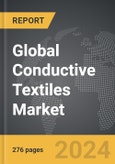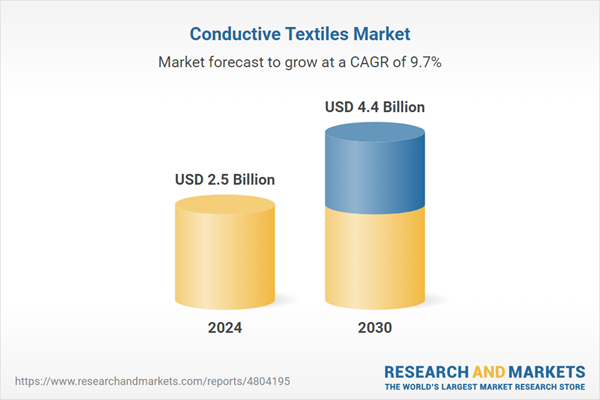The global market for Conductive Textiles was valued at US$2.5 Billion in 2024 and is projected to reach US$4.4 Billion by 2030, growing at a CAGR of 9.7% from 2024 to 2030. This comprehensive report provides an in-depth analysis of market trends, drivers, and forecasts, helping you make informed business decisions. The report includes the most recent global tariff developments and how they impact the Conductive Textiles market.
Segments: Textile (Woven, Non-Woven, Knitted); End-Use (Military & Defense, Sports & Fitness, Consumer Electronics, Healthcare, Other End-Uses).
Geographic Regions/Countries: World; United States; Canada; Japan; China; Europe (France; Germany; Italy; United Kingdom; Spain; Russia; and Rest of Europe); Asia-Pacific (Australia; India; South Korea; and Rest of Asia-Pacific); Latin America (Argentina; Brazil; Mexico; and Rest of Latin America); Middle East (Iran; Israel; Saudi Arabia; United Arab Emirates; and Rest of Middle East); and Africa.
The analysts continuously track trade developments worldwide, drawing insights from leading global economists and over 200 industry and policy institutions, including think tanks, trade organizations, and national economic advisory bodies. This intelligence is integrated into forecasting models to provide timely, data-driven analysis of emerging risks and opportunities.
Global Conductive Textiles Market - Key Trends and Drivers Summarized
How Are Conductive Textiles Set to Revolutionize Wearable Technology?
Conductive textiles, an innovative advancement in material science, are fabrics that have been engineered to conduct electricity. These textiles are typically created by weaving or embedding conductive materials, such as silver, copper, carbon, or conductive polymers, into fibers or fabrics, enabling them to transmit electrical signals or energy. The result is a flexible, lightweight material that retains the feel of regular fabrics while performing electronic functions. Conductive textiles are a cornerstone of smart clothing and wearable technology, where electronic circuits and sensors are integrated directly into garments or accessories. These fabrics are critical to the development of wearable devices that can monitor health metrics, provide communication functions, or even power small devices, offering a seamless blend of technology and everyday apparel. As the demand for functional and unobtrusive wearable technology increases, conductive textiles are expected to play an increasingly prominent role in reshaping not only the fashion industry but also healthcare, sports, and defense.In What Industries Are Conductive Textiles Gaining Ground, and Why?
Conductive textiles are making significant inroads into multiple industries, where their unique properties enable the development of a wide array of innovative applications. In the healthcare sector, conductive textiles are used to create smart garments that can monitor vital signs, such as heart rate, body temperature, and respiration. These garments provide real-time data for patients and healthcare providers, allowing for continuous, non-invasive monitoring, particularly in wearable medical devices for chronic disease management and rehabilitation. The sports and fitness industry has also embraced conductive textiles in the form of smart athletic wear that tracks performance metrics such as muscle activity, posture, and hydration levels, giving athletes and coaches critical insights for training optimization. The military and defense sectors are another key area where conductive textiles are gaining traction, particularly in the development of smart uniforms and gear. Soldiers’ garments equipped with conductive fibers can include integrated communications, sensors for health monitoring, or even embedded heating elements for thermal regulation in extreme environments. Additionally, the rise of consumer wearables, such as smartwatches and fitness trackers, has spurred interest in embedding electronics directly into clothing, allowing for seamless functionality and a more comfortable user experience. Conductive textiles are not only transforming apparel but are also finding applications in home textiles, such as smart curtains or bed linens that can regulate temperature or control lighting, further expanding their reach into everyday life.How Are Advances in Conductive Textiles Shaping Future Applications?
The development of conductive textiles is heavily influenced by advances in materials and fabrication techniques, which are continually improving their functionality, durability, and affordability. Conductive polymers, which are lightweight and flexible, are being used alongside traditional metallic fibers to create fabrics that can withstand repeated stretching, washing, and everyday wear without losing their electrical conductivity. This has made them ideal for wearable electronics that need to endure the rigors of daily use. Nanotechnology is playing an increasingly important role in this field, with nanofibers and nanoparticles being integrated into fabrics to create textiles that are not only conductive but also offer additional features, such as antimicrobial properties or enhanced strength. Graphene, a highly conductive and incredibly strong material, is also being explored for its potential to create next-generation conductive textiles that offer superior performance with minimal bulk. These material innovations are complemented by improvements in fabrication techniques such as knitting, weaving, and printing, which allow for precise integration of conductive elements into fabrics without compromising their look, feel, or comfort. As these technologies evolve, they are expected to enable a new wave of applications, from self-heating garments and energy-harvesting clothing to fabric-based touch sensors and fully integrated electronic circuits within textiles. The growing sophistication of conductive textiles is pushing the boundaries of what smart fabrics can achieve, making them an exciting frontier in the world of electronics.What Are the Factors Driving the Growth of the Conductive Textiles Market?
The growth of the conductive textiles market is driven by several interconnected factors, including the rising demand for wearable technology, advancements in material science, and the need for more efficient health monitoring solutions. One of the primary drivers is the increasing popularity of smart clothing in the fitness and sports industry, where athletes and consumers seek more accurate and convenient ways to track their physical activity and performance. Conductive textiles enable these functionalities to be seamlessly incorporated into garments, providing data without the need for additional devices. In the healthcare sector, the shift toward telemedicine and continuous health monitoring is accelerating the demand for conductive textiles, particularly for elderly and chronic patients who require constant monitoring of vital signs. This has led to increased interest from medical device manufacturers and healthcare providers in developing textile-based wearable solutions. Additionally, the defense industry is driving significant demand for conductive textiles, especially as militaries worldwide explore the use of smart uniforms that can integrate communication systems, biometric monitoring, and environmental controls. Furthermore, as consumer electronics continue to evolve, the desire for more discreet and wearable technology is pushing designers to move beyond rigid devices, turning instead to textiles that can house electronic components invisibly. Sustainability trends are also influencing the market, as companies and consumers alike look for more eco-friendly alternatives to traditional electronics. Conductive textiles, which often use less raw material and produce less waste during manufacturing, align with these goals, further propelling their adoption across industries.Report Scope
The report analyzes the Conductive Textiles market, presented in terms of units. The analysis covers the key segments and geographic regions outlined below.Segments: Textile (Woven, Non-Woven, Knitted); End-Use (Military & Defense, Sports & Fitness, Consumer Electronics, Healthcare, Other End-Uses).
Geographic Regions/Countries: World; United States; Canada; Japan; China; Europe (France; Germany; Italy; United Kingdom; Spain; Russia; and Rest of Europe); Asia-Pacific (Australia; India; South Korea; and Rest of Asia-Pacific); Latin America (Argentina; Brazil; Mexico; and Rest of Latin America); Middle East (Iran; Israel; Saudi Arabia; United Arab Emirates; and Rest of Middle East); and Africa.
Key Insights:
- Market Growth: Understand the significant growth trajectory of the Non-Woven Textile segment, which is expected to reach US$1.4 Billion by 2030 with a CAGR of a 9.1%. The Knitted Textile segment is also set to grow at 7.5% CAGR over the analysis period.
- Regional Analysis: Gain insights into the U.S. market, valued at $670.6 Million in 2024, and China, forecasted to grow at an impressive 13.8% CAGR to reach $979.2 Million by 2030. Discover growth trends in other key regions, including Japan, Canada, Germany, and the Asia-Pacific.
Why You Should Buy This Report:
- Detailed Market Analysis: Access a thorough analysis of the Global Conductive Textiles Market, covering all major geographic regions and market segments.
- Competitive Insights: Get an overview of the competitive landscape, including the market presence of major players across different geographies.
- Future Trends and Drivers: Understand the key trends and drivers shaping the future of the Global Conductive Textiles Market.
- Actionable Insights: Benefit from actionable insights that can help you identify new revenue opportunities and make strategic business decisions.
Key Questions Answered:
- How is the Global Conductive Textiles Market expected to evolve by 2030?
- What are the main drivers and restraints affecting the market?
- Which market segments will grow the most over the forecast period?
- How will market shares for different regions and segments change by 2030?
- Who are the leading players in the market, and what are their prospects?
Report Features:
- Comprehensive Market Data: Independent analysis of annual sales and market forecasts in US$ Million from 2024 to 2030.
- In-Depth Regional Analysis: Detailed insights into key markets, including the U.S., China, Japan, Canada, Europe, Asia-Pacific, Latin America, Middle East, and Africa.
- Company Profiles: Coverage of players such as Aiq Smart Clothing Inc., Coatex Industries, Emei (HK) Electronics Ltd., HITEK Electronic Materials Ltd, Holland Shielding Systems BV and more.
- Complimentary Updates: Receive free report updates for one year to keep you informed of the latest market developments.
Some of the 47 companies featured in this Conductive Textiles market report include:
- Aiq Smart Clothing Inc.
- Coatex Industries
- Emei (HK) Electronics Ltd.
- HITEK Electronic Materials Ltd
- Holland Shielding Systems BV
- Jarden Applied Materials
- Laird PLC
- Marktek Inc.
- NV Bekaert SA
- Parker Chomerics
- Seiren Co., Ltd.
- Swift Textile Metalizing, LLC
- Toray Industries, Inc.
Tariff Impact Analysis: Key Insights for 2025
Global tariff negotiations across 180+ countries are reshaping supply chains, costs, and competitiveness. This report reflects the latest developments as of April 2025 and incorporates forward-looking insights into the market outlook.The analysts continuously track trade developments worldwide, drawing insights from leading global economists and over 200 industry and policy institutions, including think tanks, trade organizations, and national economic advisory bodies. This intelligence is integrated into forecasting models to provide timely, data-driven analysis of emerging risks and opportunities.
What’s Included in This Edition:
- Tariff-adjusted market forecasts by region and segment
- Analysis of cost and supply chain implications by sourcing and trade exposure
- Strategic insights into geographic shifts
Buyers receive a free July 2025 update with:
- Finalized tariff impacts and new trade agreement effects
- Updated projections reflecting global sourcing and cost shifts
- Expanded country-specific coverage across the industry
Table of Contents
I. METHODOLOGYII. EXECUTIVE SUMMARY2. FOCUS ON SELECT PLAYERSIII. MARKET ANALYSISSOUTH KOREAREST OF ASIA-PACIFICARGENTINABRAZILMEXICOREST OF LATIN AMERICAIRANISRAELSAUDI ARABIAUNITED ARAB EMIRATESREST OF MIDDLE EASTIV. COMPETITION
1. MARKET OVERVIEW
3. MARKET TRENDS & DRIVERS
4. GLOBAL MARKET PERSPECTIVE
UNITED STATES
CANADA
JAPAN
CHINA
EUROPE
FRANCE
GERMANY
ITALY
UNITED KINGDOM
SPAIN
RUSSIA
REST OF EUROPE
ASIA-PACIFIC
AUSTRALIA
INDIA
LATIN AMERICA
MIDDLE EAST
AFRICA
Companies Mentioned (Partial List)
A selection of companies mentioned in this report includes, but is not limited to:
- Aiq Smart Clothing Inc.
- Coatex Industries
- Emei (HK) Electronics Ltd.
- HITEK Electronic Materials Ltd
- Holland Shielding Systems BV
- Jarden Applied Materials
- Laird PLC
- Marktek Inc.
- NV Bekaert SA
- Parker Chomerics
- Seiren Co., Ltd.
- Swift Textile Metalizing, LLC
- Toray Industries, Inc.
Table Information
| Report Attribute | Details |
|---|---|
| No. of Pages | 276 |
| Published | April 2025 |
| Forecast Period | 2024 - 2030 |
| Estimated Market Value ( USD | $ 2.5 Billion |
| Forecasted Market Value ( USD | $ 4.4 Billion |
| Compound Annual Growth Rate | 9.7% |
| Regions Covered | Global |









